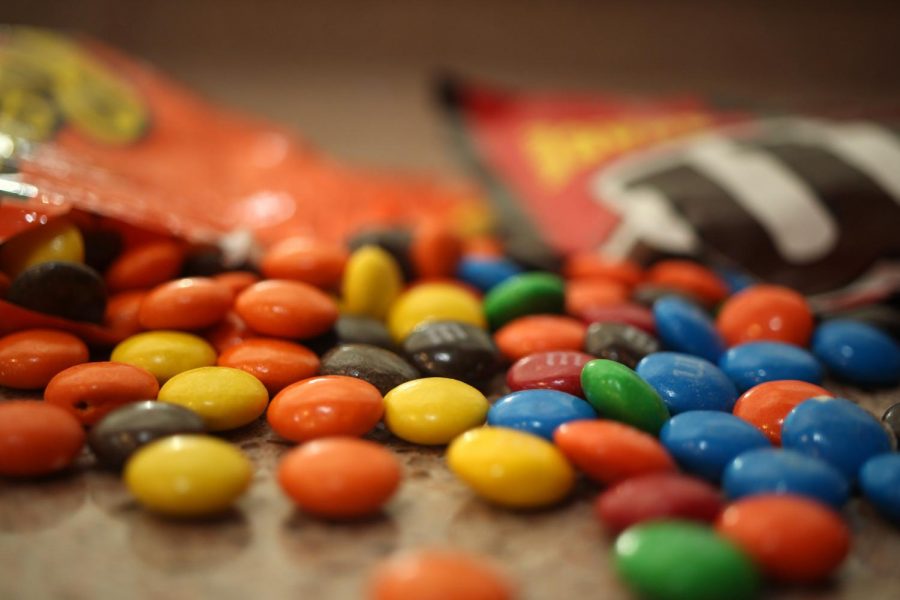
Dogs can indeed eat some Reese’s Pieces since this occasional dessert does not contain substances that can be harmful for dogs, such as chocolate or raisins. We do not suggest giving Reese’s Pieces to your pup as they’re not healthy.
In contrast to regular Edamame which provides nutrition benefits for your pet’s body, Reese’s Pieces are candied with a high fat and sugar content. If your dog loves the taste of crunchiness and texture, we’ve put together alternative dog-friendly treats that offer the health benefits and nutrition for your dog below.
What are Reese’s Pieces?
Reese’s Pieces is an American classic candy that was first released in the market in US market in the month of September 1978. It wasn’t until 1980 that Reese’s Pieces was introduced to the Canadian market.
If you’re a big fan of E.T. the Extra-Terrestrial film, you will know that Reese’s Pieces was featured in the movie in 1982. Reese’s Pieces became popular after the release of the film.
Reese’s Pieces are derived from Reese’s Peanut Butter Cups line. The two candies are alike in the sense that they both have peanut butter as their primary ingredient. They are different in that Reese’s Pieces do not have any chocolate.
Instead the peanut butter candy is a round, flat shape and is covered with various candy shells of different colors. It’s roughly exactly the size of the squash seeds and is available on the market in 3 colors: orange yellow and brown.
What are the ingredients of Reese’s Pieces? Let’s find out.
Ingredients in Reese’s Pieces
Here are the main ingredients of Reese’s Pieces:
- Peanuts.
- Sugar.
- Corn syrup.
- Vegetable oil.
Each Reese’s Piece has 2% or less of the following ingredients:
- Salt.
- Milk.
- Soy lecithin.
- Cornstarch.
- Vanilla.
- Carnauba wax.
- Artificial flavors.
- Artificial colors.
As you can observe, Reese’s Pieces were made for consumption by humans. Certain ingredients found in the candy could trigger allergic reactions in dogs, including peanuts and soy.
Dogs who are sensitive to products containing soy might suffer from these symptoms:
- Inflammation of the eyelids, also known as Blepharitis.
- Loss of hair due to the excessive scratching their fur and skin.
- Diarrhea.
- Vomiting.
- Are suffering from seborrhea, a condition wherein they often discharge sebum.
- Ear infections.
It is good to know that most canines aren’t in any way allergic to peanuts. Indeed there are many dogs who love the flavor of peanut butter and it could be among their most-loved snacks. However, dogs suffering from allergic reactions to peanuts might be afflicted with mild or severe symptoms that include:
- Bald spots are caused by excessive licking of their coats and skin.
- Trouble breathing.
- Agitation.
- The itchy skin of your dog causes him to scratch often.
- Skin red from regular scratching.
We’ll discuss further peanut allergies in the next section.
If you have to offer Reese’s Pieces with your furry companions or even falls to look at the puppy’s eyes make ensure to separate the Candy into pieces smaller and ensure there aren’t sharp edges. It’s recommended to give them just one or two each of Reese’s Pieces and see how they react.
If they do If they react, don’t offer them any additional Reese’s Pieces candy, and go to your vet immediately to determine if your pet requires any immediate treatment. If they’re okay just give them treats every once in each month or every couple of months.
How do I know whether my dog is suffering from an allergy to peanut butter?

If your dog’s four-legged friend has an allergy to peanut butter you’ll be able to tell immediately. Most dogs will suffer from moderate, mild, and severe allergic reactions to peanut butter quickly after eating it.
There are the following signs that can be a sign of allergic reaction to peanuts in pets:
- Vomiting.
- Sudden diarrhea.
- The excessive licking of their skin.
- Excessive drooling.
- Skin that is itchy or red.
- Hotspots.
- Heart rate and beats that are fast.
- Agitation.
- Pulse is less powerful.
- Bald spots.
- Breathing difficulties.
There are two kinds of peanut butter allergies in dogs. These are:
- Reactions to the body’s internal organs.
- Atopic dermatitis or skin allergies.
Dogs suffering from the most severe form of an allergy reaction are likely to be in a state of anaphylactic shock. Take your pet to the vet right away. The vet will likely inject your dog with adrenaline.
The good news is that treatments are usually successful and your pet will fully recover. The vet can prescribe EpiPen or allergy medicines in case this occurs again.
What happens when my dog eats too many Reese’s Pieces?
If your dog ate more than Reese’s Pieces, they are at risk of having an excess amount of sugar and fat consumption. Let’s look at the nutritional content of a single serving from Reese’s Pieces:
Nutritional Profile of Reese’s Pieces (Per Piece)
| Name, Unit | Amount |
| Calories, cal | 3.9 |
| Sugar, g | 0.41 |
| Sodium, mg | 0.88 |
| Carbohydrate, g | 0.49 |
| Total Fat, g | 0.18 |
| Saturated Fat, g | 0.16 |
| Protein, g | 0.08 |
| Fiber, g | 0.02 |
| Iron, mg | 0.72 |
That means that a single portion of Reese’s Pieces has about 4 calories, 0.18 grams of fat (0.16 grams saturated) as well as 0.49 grams of carbohydrates (0.41 grams sugar).
So in one bite of Reese’s Pieces, 80% is fat and sugar. If your dog consumes the candy, it’s similar to taking a bite of raw sugar or fat. A couple of portions from Reese’s Pieces is fine for your dog, but because the candy is small and vibrant, dogs could accidentally eat a large amount of it even when you’re not paying attention.
Make sure you keep Reese’s Pieces plastic packets on an elevated shelf, away from view or in a place in which your pet cannot reach them. If they are within range, your dog could accidentally eat the entire packet. This could be fatal because the quantity of fat, sugar and calories absorbed by the system could have either immediate or long-term consequences.
The immediate effects could be diarrhea, vomiting constipation, stomach discomfort, and constipation due to the fact that your dog could have been suffering from GI discomfort.
In addition eating excessive amounts of Reese’s Pieces or eating them each day could lead to ailments like obesity, diabetes and heart disease. It can also lead to even pancreatitis. Let’s look into each of these effects.
Sugar is a risk found in Reese’s Pieces
Because one bite from Reese’s Pieces has over 50 percent sugar this is already excessive sugar for your dog. Dogs don’t require this much sugar and taking too much of this candy could trigger digestive problems immediately.
At first, your pet could have stomach problems like vomiting and diarrhea due to the excessive sugar (that your pet doesn’t need) is draining water of your dog’s system and transferring it to the intestines of your dog. Your dog’s companion could be suffering from digestive issues and may become dehydrated.
In the second, your pet might begin to increase in weight.
Reese’s Pieces should be an occasional treat and not something you offer your pet every day. If you offer them to your dog each day your body will develop a high-fat percentage which can cause problems such as diabetes, obesity, and metabolic problems.
Remember that your dog’s condition could slowly worsen, because one health issue can lead to another problem. Instead of strong muscles the body of your dog will be a heavy fat composition, which could make them heavier, leading to joint issues, a lack of exercise, and being unmotivated to move.
Third, your dog might suffer from tooth decay. According to Brandywine Valley, 80 percent of dogs suffer from periodontal diseases or dental diseases before three years old, so feeding your pet more sugar won’t aid in reducing this issue.
Danger of fat in Reese’s Pieces
While dogs need certain amounts of fat as macronutrients for the functioning of the brain and to maintain the health of their coat, skin, and eyes, excessive consumption of fat can result in an increase in fat tissue.
In reality, according to the National Academy of Sciences, the 33-pound dog can only take in 14g of fat each day.
The dog will then begin in gaining weight. What’s more, the fatty tissue can put stress on the bones and joints as well in the internal organs, which can affect their body and organ functions.
As time passes, like the dangers associated with sugar, having a high-fat content within their bodies can result in obesity, heart disease as well as diabetes. Actually, your pet could be diagnosed with chronic pancreatitis in the event that he eats an excessive amount of food that has high fat levels in a brief period.
Acute pancreatitis can be serious due to the rapid consumption of fat causes the pancreas to be rapidly inflamed and then the pancreas is broken into pieces internally.
Here are a few signs of pancreatitis:
- Lethargy.
- Abdominal discomfort.
- Vomiting.
- Afraid to bend or slump in the pain.
- Fever.
If you experience any of these signs take your dog to the vet immediately so that your pet is treated before it turns into a serious situation , and the pancreas begins to deteriorate further. A prompt diagnosis means treating issues earlier and allowing your dog to heal from pancreatitis.
If the situation is life-threatening, the vet for your dog is likely to prescribe IV fluids and anti-inflammatory medication and painkillers to help keep your pet safe.
Do you have to feed Reese’s Pieces to your dog even if they’re over their expiration date?

Yes, however, we don’t recommend feeding your pet Reese’s Pieces that are past their expiration date just the way you wouldn’t consume food that is expired. Because Reece’s Pieces are stuffed with sugar, they usually have a longer shelf-life. Reese’s Pieces past their best-by-date can change their flavor and texture.
For dogs, they won’t be aware and won’t take any notice. However, as a responsible dog owner is it best to not offer your dog anything beyond its expiration date.
What should I do when my pet has eaten more than Reese’s Pieces?
In the first place, don’t make your dog vomit if he consumed a large number of Reese’s Pieces. Inflicting vomiting on your dog can be detrimental to your dog. If you suspect that your dog has eaten multiple servings or packets of Reese’s Pieces, call or visit your veterinarian as soon as you can.
Your dog’s veterinarian will guide you on the most effective way to go about it. If they advise throwing up is the best way to go and they suggest that you apply 3 percent hydrogen peroxide in a dose of one teaspoon per 5 pounds body weight so that your dog will be able to throw up.
Generally, you should throw away all of the items from Reese’s Pieces and make sure that your pet is drinking plenty of fluids and avoid eating anything else throughout the day. Let your dog speed up if he’s suffering from vomiting or diarrhea.
Also, can dogs consume Reese’s Pieces?
Dogs can be fed Reese’s Pieces, but only just a handful. In particular, it is recommended to eat just 2 , or 3 pieces at least. The candy is small and bright enough for dogs, and they are able to eat the entire bag if they are able to. It is important to note that Reese’s Pieces contain a significant amount of sugar and fat that can trigger acute health issues that can result in vomiting, diarrhea or perhaps acute pancreatitis.
In the long run over time, your dog may suffer from dental issues like tooth decay, gain unneeded weight, suffer from heart disease and diabetes.
The next time you see their puppy eye, think twice and offer them a handful as a treat every now and then.